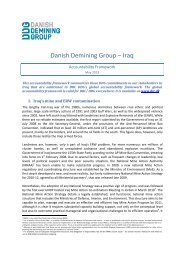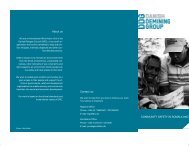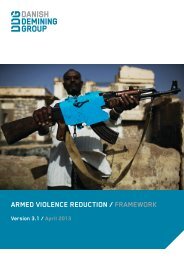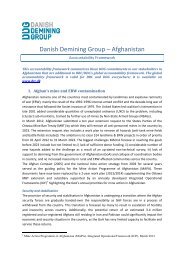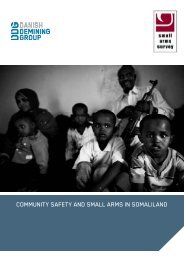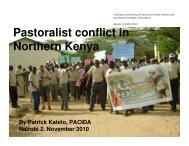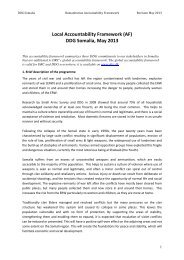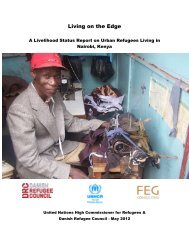18 DRC / DANISH REFUGEE COUNCILdo not possess <strong>the</strong> skills that are most demanded on <strong>the</strong> Kabul labour market: carpetweaving, repairing of electronic and electric equipment, metalwork, carpentry and automechanics13 . This is important in assessing <strong>the</strong> relevance of cash-for-training programmes,calling for consideration of <strong>the</strong> actual state of <strong>the</strong> labour market demand to ensure skills areresponsive to it and do not require high levels of literacy or numeracy to ensure employabilityof participants.Female bread earners: Not surprisingly, <strong>the</strong>re is a clear difference between men and women:93% of <strong>the</strong> surveyed male respondents <strong>report</strong>ed contributing to <strong>the</strong> income of <strong>the</strong>irhousehold – but only 31% of <strong>the</strong> female interviewees. However, if we only consider <strong>the</strong>female heads of household (43% of <strong>the</strong> female respondents, 31 out of 72), this percentagegoes up to 55% with 17 of <strong>the</strong> 31 female heads of households who <strong>report</strong>ed contributing to<strong>the</strong> income of <strong>the</strong>ir household. Surveyed working women mentioned domestic work (45%), dailylabour (27%) and begging (14%) as <strong>the</strong>ir main activities. In Sustaining <strong>the</strong> Working Poor in <strong>the</strong> KabulInformal Settlements 14 , research highlights women in KIS have skills that can be used in incomegeneratingactivities. Observations on <strong>the</strong> field and discussions with DRC field team howeverunderlined specificities according to camps: females in Bagh-e Dawood for instance, had morefreedom of movement and community support to participate in livelihood interventions, whereassocial and cultural barriers were higher in o<strong>the</strong>r communities, such as Jogis. Taking <strong>the</strong>se specificitiesinto account in <strong>the</strong> design of <strong>the</strong> programme and understanding community structures will be crucialin identifying <strong>the</strong> most adequate forms of intervention in a given camp, and underline <strong>the</strong> importanceof <strong>the</strong> involvement of <strong>the</strong> community through clear explanation of <strong>the</strong> expected outcomes andbenefits of <strong>the</strong> intervention.Dependency Ratio: Combined to <strong>the</strong> high degree on reliance on debts and instability due toseasonal disruption of income, little diversity in <strong>the</strong> sources of income can raise <strong>the</strong>vulnerability of households to external shocks 15 . One of <strong>the</strong> main findings from <strong>the</strong>quantitative survey was a heavy dependency on <strong>the</strong> earnings of <strong>the</strong> breadwinner of <strong>the</strong> family.The dependency ratio was found to be particularly high, with an average of 1.9, as opposedto 1.3 for urban poor according to NRVA 16 . This can be explained both by <strong>the</strong> high childrenpopulation in <strong>the</strong> sites surveyed (31% of households were “large families”, with over 5household members, a category within Extremely Vulnerable households according toUNHCR guidelines) and a reduced diversity in income sources.Income stability and seasonality: The stability of households’ income is deeply impacted byseasonal variations with winter-related shocks and additional winter-related assistanceneeded. The quantitative survey looked specifically at <strong>the</strong> seasonal variations in <strong>the</strong> accessto food by IDP households in <strong>the</strong> KIS, given that <strong>the</strong>ir highest expenditures are food-based.The quantitative data showed variations in <strong>the</strong> ability of respondents to satisfy <strong>the</strong>ir foodneeds according to <strong>the</strong> season but also according to <strong>the</strong> camp <strong>the</strong>y live in. During <strong>the</strong> warmseasons, respondents mentioned not having borrowed money to pay for food purchasesmore than 10 times. During spring and summer, <strong>the</strong> majority of <strong>the</strong> households surveyed(93% for each season) indicated having borrowed money for food up to 4 times. Only 0.5%of households stated having have borrowed money 10 times for purchasing food in <strong>the</strong>spring, and 2.7% in <strong>the</strong> summer. In autumn, 89% of <strong>the</strong> households <strong>report</strong>ed borrowing upto 4 times for purchasing food, and 1.3% 10 times to <strong>the</strong> same purpose. Winter verydistinctly appeared as <strong>the</strong> season with <strong>the</strong> greater difficulties for meeting <strong>the</strong>ir foodexpenses; one household mentioning having borrowed up to 60 times for purchasing fooditems. The majority of respondents (67.5%) <strong>report</strong>ed borrowing up to 5 times, and 5% up to10 times. In Kabul Nandari, 50% of respondents mentioned facing problems to address foodneeds more than several times per month. This was <strong>the</strong> case for 47.5% of respondents inBlock-hai Hewadwal and Nasaji Bagrami. In Block-hai Qasaba and Charah-i Qambar, <strong>the</strong>13 Ibid.14 SAMUEL HALL CONSULTING (2012), Sustaining <strong>the</strong> Working Poor in <strong>the</strong> Kabul Informal Settlements, SolidaritésInternational..15 C. ARNOLD, T. CONWAY, M. GREENSLADE, “Cash Transfer Literature Review”, DFID, UKAID, Policy Division, April 2011.16 NRVA, 2007-08: A profile of Afghanistan.
CASH PROGRAMME REVIEW FOR IDPs IN KABUL INFORMAL SETTLEMENTS 19percentage was lower, with respectively 32.5 and 27.5% of respondents mentioning similarproblems. This calls for camp-specific approaches in <strong>the</strong> design of programmes and <strong>the</strong>assessment of needs of communities targeted by cash assistance. Considering differentcash approaches or combinations with in-kind, for instance, might be a way to addressefficiently <strong>the</strong> specific needs of communities.“We don’t have any problems of foods and fuel in o<strong>the</strong>r season, because our men are working in<strong>the</strong> warm seasons.”- Female FGD – Nasaji Karte“In <strong>the</strong> summer we don't have many problems. Our men cannot find work in <strong>the</strong> winter. Do youthink people will wash <strong>the</strong>ir cars in <strong>the</strong> winter? No, of course <strong>the</strong>y don't. My husband and my sonwash cars, but in <strong>the</strong> winter people don't wash <strong>the</strong>ir cars because it gets dirty very soon”- Female FGD, Parwan 2, 38 years old“We didn’t have fuel and we were also jobless, we are all daily labourers and in <strong>the</strong> winter <strong>the</strong>re isno enough construction work”- Male FGD, Charahi Qambar, 47 years oldGraph 1: Household strategies to meet <strong>the</strong>ir food needs.50,045,040,035,030,0 26,507525,020,728620,018,341716,457315,09,673410,05,0-6,9095,7538 ,6281Spending patterns: The surveyed households’ cash incomes are mostly spent on satisfying<strong>the</strong>ir immediate needs, with an overwhelming mention of food (61%), followed by energy(14%), clothing and medical treatment (9% respectively). Expenditure on <strong>the</strong>se itemsconstitutes <strong>the</strong>ir top priority, collectively absorbing approximately 93% of <strong>the</strong>ir totalresources. The livelihoods of surveyed households are <strong>the</strong>refore at high risk of beingdisturbed, highlighting <strong>the</strong> appropriateness of livelihood interventions supporting alternativegeneration of income. With only 3% of resources in hand after meeting demands for basicneeds, respondents are unable to repay <strong>the</strong>ir debts, maintain or improve <strong>the</strong>ir abodes, lookafter <strong>the</strong>ir children’s education or start small-scale businesses. The average monthlyexpenditure of households in our sample is 9,203 Afghani, which is almost 30% lower than



